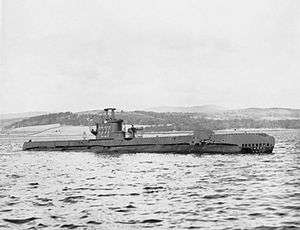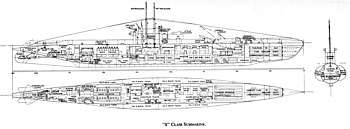HMS Spiteful (P227)
HMS Spiteful (Pennant number P227) was a third-batch S-class submarine built for the Royal Navy during the Second World War.
 Spiteful | |
| History | |
|---|---|
| Name: | Spiteful |
| Builder: | Scotts, Greenock |
| Laid down: | 19 September 1941 |
| Launched: | 5 June 1943 |
| Commissioned: | 6 October 1943 |
| Decommissioned: | 15 July 1963 |
| Identification: | Pennant number: P227 |
| Fate: | Scrapped |
| Badge: |
 |
| General characteristics | |
| Class and type: | S-class submarine |
| Displacement: |
|
| Length: | 217 ft (66.1 m) |
| Beam: | 23 ft 9 in (7.2 m) |
| Draught: | 14 ft 8 in (4.5 m) |
| Installed power: |
|
| Propulsion: |
|
| Speed: |
|
| Range: | 6,000 nmi (11,000 km; 6,900 mi) at 10 knots (19 km/h; 12 mph) (surfaced); 120 nmi (220 km; 140 mi) at 3 knots (5.6 km/h; 3.5 mph) (submerged) |
| Test depth: | 300 ft (91.4 m) |
| Complement: | 48 |
| Sensors and processing systems: |
|
| Armament: |
|
Design and description

The S-class submarines were designed to patrol the restricted waters of the North Sea and the Mediterranean Sea. The third batch was slightly enlarged and improved over the preceding second batch of the S-class. The submarines had a length of 217 feet (66.1 m) overall, a beam of 23 feet 9 inches (7.2 m) and a draught of 14 feet 8 inches (4.5 m). They displaced 865 long tons (879 t) on the surface and 990 long tons (1,010 t) submerged.[1] The S-class submarines had a crew of 48 officers and ratings. They had a diving depth of 300 feet (91.4 m).[2]
For surface running, the boats were powered by two 950-brake-horsepower (708 kW) diesel engines, each driving one propeller shaft. When submerged each propeller was driven by a 650-horsepower (485 kW) electric motor. They could reach 15 knots (28 km/h; 17 mph) on the surface and 10 knots (19 km/h; 12 mph) underwater.[3] On the surface, the third-batch boats had a range of 6,000 nautical miles (11,000 km; 6,900 mi) at 10 knots (19 km/h; 12 mph) and 120 nmi (220 km; 140 mi) at 3 knots (5.6 km/h; 3.5 mph) submerged.[2]
The boats were armed with seven 21-inch (533 mm) torpedo tubes. A half-dozen of these were in the bow and there was one external tube in the stern. They carried six reload torpedoes for the bow tubes for a total of thirteen torpedoes. Twelve mines could be carried in lieu of the internally stowed torpedoes. They were also armed with a 3-inch (76 mm) deck gun.[4] It is uncertain if Spiteful was completed with a 20-millimetre (0.8 in) Oerlikon light AA gun or had one added later. The third-batch S-class boats were fitted with either a Type 129AR or 138 ASDIC system and a Type 291 or 291W early-warning radar.[5]
Career
Her first war patrol was in the North Atlantic, from 29 December 1943 to 12 January 1944. She returned to Lerwick, in Shetland, where a battery was replaced and a "singing" screw was repaired.
She sailed for Ceylon, arriving in April 1944. She was assigned to 8th Flotilla, HMS Maidstone. She made two patrols, then transited to Fremantle. She sunk a number of Japanese vessels with gunfire, on 30 June, 2 July and 14 December.[6]
Another incident involved USS Gabilan, when the American ship almost fired upon her, before recognising her as a friendly ship.
Spiteful then bombarded installations on the Andaman Islands and Christmas Island. She made three further patrols, totalling 109 days at sea - the three longest patrols by any S-class submarine - 34, 38 and 37 days (Sirdar achieved one of 49 days) - with little luck. She returned to the UK in April 1945 for a refit.
French service
She was loaned to France as Sirène from 1952 to 1958.
On 1 July 1963 she arrived at Faslane to be broken up 15 July 1963.
Notes
- Akermann, p. 341
- McCartney, p. 7
- Bagnasco, p. 110
- Chesneau, pp. 51–52
- Akermann, pp. 341, 345
- HMS Spiteful, Uboat.net
References
- Akermann, Paul (2002). Encyclopaedia of British Submarines 1901–1955 (reprint of the 1989 ed.). Penzance, Cornwall: Periscope Publishing. ISBN 978-1-904381-05-1.
- Bagnasco, Erminio (1977). Submarines of World War Two. Annapolis, Maryland: Naval Institute Press. ISBN 978-0-87021-962-7.
- Chesneau, Roger, ed. (1980). Conway's All the World's Fighting Ships 1922–1946. Greenwich, UK: Conway Maritime Press. ISBN 978-0-85177-146-5.
- McCartney, Innes (2006). British Submarines 1939–1945. New Vanguard. 129. Oxford, UK: Osprey. ISBN 978-1-84603-007-9.